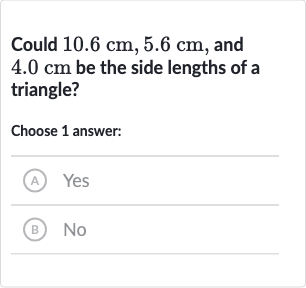Full solution
Q. Could , and be the side lengths of a triangle?Choose answer:(A) Yes(B) No
- Check Triangle Inequality Theorem: To determine if three lengths can form a triangle, we use the Triangle Inequality Theorem, which states that the sum of the lengths of any two sides of a triangle must be greater than the length of the third side. We will check this for all three combinations of sides.
- Calculate Sum of Two Shorter Sides: First, we check if the sum of the two shorter sides, and , is greater than the longest side, . We calculate and compare it to .
- Verify Theorem Not Satisfied: The sum of the two shorter sides is , which is not greater than the longest side, . This means that the Triangle Inequality Theorem is not satisfied.
- Conclusion: Since the sum of the lengths of the two shorter sides is not greater than the length of the longest side, the lengths , , and cannot form a triangle.
More problems from Is (x, y) a solution to the system of equations?
QuestionGet tutor help

